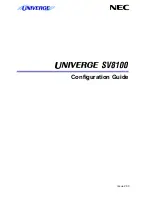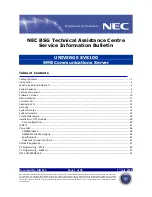
Issue 2.0
10-6
SV9100 NetLink
Figure 10-2 Two SV9100 Systems Connected Via the WAN
systems. One on the corporate local LAN and one on a Remote network
connected via the WAN. The remote site cannot call the MAIN site, therefore, it is
not working.
The green arrow in
Figure 10-2 Two SV9100 Systems Connected Via the WAN
represents the data packets leaving the REMOTE IPLE card destined for the
SV91000 on the Headquarters LAN. The firewall on the Headquarters network is
not configured to recognize the TCP/UDP ports utilized by the NEC equipment,
thus blocking them resulting in registration failure. To solve this issue the ports
used by the NEC VoIP equipment must be opened in the firewall allowing the
NEC traffic to pass through onto the SV9100.
The ports, 58000 and 58002 (TCP) for signaling and the voice ports, are required
to be open at each location. This depends on how many IPLE ports are installed.
IPLE 256 Open UDP Ports
10020~10531
VPN
Another common feature is to use the Internet as the WAN between customer
locations. When this is done VPNs are typically used between the locations. A
VPN (Virtual Private Network) is a private data network that maintains privacy
through the use of tunneling protocols and security features over the public
internet. This allows remote networks (with private addresses), residing behind
NAT routers and/or firewalls, to communicate freely with each other. When
building the VPN tunnels, throughout the network, they must be assigned as a
fully meshed network. This means that every network is allowed direct connection
to each and every other network in the topology.
Figure 10-2 Two SV9100 Systems Connected Via the WAN
WAN
Headquarters
Local LAN
Remote Network
Firewall
Firewall
Summary of Contents for Univerge SV9100
Page 1: ...Networking Manual A50 035910 004 AU Issue 2 0...
Page 20: ...xviii Table of Contents Issue 2 0...
Page 26: ...xxiv List of Figures Issue 2 0...
Page 33: ...Book 1 SV9100 K CCIS...
Page 49: ...Issue 2 0 1 16 General Information US Only Figure 1 15 Circuit Identification Codes CIC...
Page 53: ...Issue 2 0 1 20 General Information US Only...
Page 61: ...Issue 2 0 2 8 Hardware Installation US Only...
Page 195: ...Issue 2 0 4 116 Features and Specifications...
Page 242: ...Book 2 SV9100 IP Networking...
Page 256: ...Issue 2 0 2 12 IP Networking...
Page 312: ...Issue 2 0 4 48 Programming...
Page 376: ...Issue 2 0 6 30 SIP Trunking...
Page 391: ...Issue 2 0 7 14 H 323 Trunking...
Page 467: ...Issue 2 0 8 76 IP Multiline Station SIP...
Page 551: ...Issue 2 0 10 64 SV9100 NetLink Conditions None Feature Cross Reference None...
Page 567: ...Issue 2 0 10 80 SV9100 NetLink Conditions None Feature Cross Reference None...
Page 579: ...Issue 2 0 11 6 NAPT...
Page 580: ...Issue 2 0 SV9100 Networking Manual 11 7...
Page 581: ...Issue 2 0 11 8 NAPT...
Page 582: ...Issue 2 0 SV9100 Networking Manual 11 9...
Page 583: ...Issue 2 0 11 10 NAPT...
Page 584: ...Issue 2 0 SV9100 Networking Manual 11 11...
Page 595: ...Issue 2 0 12 4 All DSP Busy Indication...
Page 671: ...Issue 2 0 13 76 AspireNet Conditions None Feature Cross Reference None...
Page 685: ...Issue 2 0 13 90 AspireNet Department Calling Flexible System Numbering Intercom...
Page 707: ...Issue 2 0 13 112 AspireNet Default Trunk Port Number Name 1 Line 001 2 Line 002 400 Line 400...
Page 713: ...Issue 2 0 13 118 AspireNet Department Calling...
Page 765: ...Issue 2 0 13 170 AspireNet...
















































